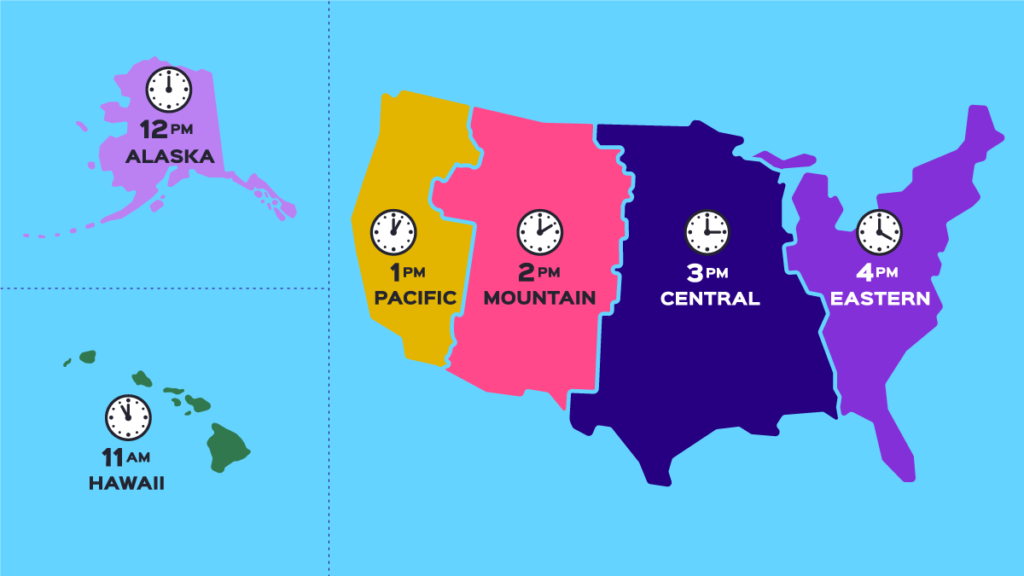How to Adjust Your Schedule for USA Time Zones

How to Adjust Your Schedule for USA Time Zones
Navigating the vast landscape of time zones in the USA can feel like a daunting task. Whether you’re traveling for business, connecting with friends across states, or simply trying to manage work commitments, understanding how to adjust your schedule is crucial. The United States spans six primary time zones, each with its own quirks and challenges. One moment you might be scheduling a meeting at 10 AM PST while your colleague on the East Coast is just settling into their lunch break. The key lies in mastering these nuances so that you can stay connected and productive no matter where you are or who you’re communicating with. Ready to dive into the world of USA Time Zones? Let’s explore how to make sense of it all!
The Importance of Time Zones in the USA
Time zones play a vital role in how we function day to day across the United States. With such a vast territory, different regions experience daylight at varying times, affecting work hours and daily activities.
Understanding these time zones is essential for businesses operating nationwide. A missed meeting or delayed response can lead to misunderstandings and lost opportunities.
Moreover, they influence travel plans significantly. Whether it’s booking flights or scheduling events, knowing the local time helps avoid confusion.
Social interactions also hinge on time awareness. Coordinating calls with friends or family who live hundreds of miles apart becomes smoother when you grasp their local clock.
In an increasingly globalized world, being attuned to U.
S. time zones fosters better collaboration and connection among people across states—crucial for both personal relationships and professional success!
Understanding the Different Time Zones in the USA
The United States spans multiple time zones, creating a complex tapestry of local times. There are six primary time zones that cover the continental U.
S.: Eastern, Central, Mountain, Pacific, Alaska, and Hawaii-Aleutian.
Eastern Time is home to major cities like New York and Washington D.
C., operating 5 hours behind Coordinated Universal Time (UTC-5). Central Time follows closely at UTC-6 and includes bustling areas such as Chicago and Dallas.
Next is Mountain Time. It’s UTC-7 and encompasses states like Colorado and Utah. Then comes Pacific Time at UTC-8 with iconic locations such as Los Angeles and San Francisco.
Alaska operates on its own schedule at UTC-9 while Hawaii lags even further behind at UTC-10. Each zone has unique quirks impacted by geography, daylight saving adjustments, and regional cultures. Understanding these differences is crucial for effective communication across the country.
Tips for Adjusting Your Schedule
Adjusting your schedule for USA Time Zones requires a strategic approach. Start by identifying the specific time zone you need to align with. This clarity helps streamline your planning.
Once that’s done, consider shifting your daily routine gradually. If you’re transitioning from Pacific to Eastern time, try going to bed and waking up 15-30 minutes earlier each day until you’re synced.
Prioritize tasks based on when others are active in their respective zones. Schedule important meetings during overlapping hours for maximum engagement.
Also, keep track of holidays and events unique to each region. Understanding local customs can enhance communication and collaboration.
Be flexible. Sometimes unexpected changes arise due to differing schedules or emergencies; adaptability is key in managing this smoothly.
Using Technology to Help with Time Zone Adjustments
Technology plays a crucial role in managing time zone adjustments. Various apps are designed specifically to help you track multiple time zones effortlessly.
World clock applications allow you to see the current time across different locations at a glance. This feature is especially useful for scheduling meetings or calls with colleagues spread across the country.
Calendar tools can also be synced with your local timezone settings, ensuring that all events and reminders reflect accurate timings wherever you may be.
For those who travel frequently, smartwatches can provide instant notifications while automatically adjusting to new time zones as you move.
Additionally, communication platforms often display participants’ local times during virtual meetings, reducing confusion significantly. With these technological aids at your disposal, navigating USA Time Zones becomes much more manageable and streamlined.
Staying Productive Across Time Zones
Staying productive across time zones can be challenging, but it’s achievable with the right strategies. First, establish a consistent work routine that aligns with your most productive hours. This helps you stay focused.
Prioritize tasks based on deadlines and time zone differences. Use tools like shared calendars to keep track of when colleagues are available or when meetings are scheduled across regions.
Break your day into manageable chunks. Short breaks help maintain energy levels while allowing your mind to reset.
Consider using techniques such as the Pomodoro Technique, which encourages bursts of concentrated effort followed by brief rests. This method can be particularly effective in maintaining productivity regardless of location.
Communicate openly with team members about your availability and preferences. Clear communication fosters collaboration and minimizes misunderstandings related to time zone differences.
How to Handle Jet Lag and Travel Fatigue
Jet lag can hit hard, especially after crossing multiple time zones in the USA. The body clock struggles to adjust, leading to fatigue and disorientation.
To ease the transition, focus on hydration before and during your flight. Water helps combat dryness and keeps you alert. Avoid excessive caffeine or alcohol as they may disrupt sleep patterns.
Once you arrive at your destination, try to sync with local time immediately. If it’s daytime where you are, resist the urge for a nap—stay active instead. A short walk can help reset your internal clock.
Consider adjusting your schedule a few days before travel too. Gradually shift bedtime closer to that of your new location.
Prioritize restful sleep once you’re settled in. Create a calming environment: darken the room and limit screen exposure an hour before bed to promote better rest.
Conclusion
Adjusting your schedule for USA time zones can be a game-changer, especially if you are working or traveling across different states. Understanding the importance of these time zones helps to navigate personal and professional commitments effectively.
By familiarizing yourself with each zone—Eastern, Central, Mountain, and Pacific—you’ll gain clarity on how they impact communication and scheduling. Implementing practical tips can ease the transition between time zones. Whether it’s setting reminders or planning meetings at optimal times, small adjustments make a big difference.
Embracing technology also plays a vital role in managing your schedule. Utilize apps that convert time zones effortlessly to save you from confusion during crucial moments. Additionally, staying productive requires strategic planning around peak hours in various locations while being mindful of potential distractions.
Jet lag is another challenge faced by many travelers moving through multiple regions rapidly. Simple practices like maintaining hydration and using light exposure will help reset your internal clock more quickly.
Navigating through USA time zones might feel daunting at first but with effective strategies and tools in place, you’ll find it easier to manage both work obligations and leisure activities seamlessly across the country. Your ability to adapt can lead not only to increased productivity but also enhanced relationships as you connect more meaningfully across different regions.








